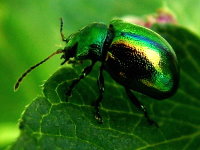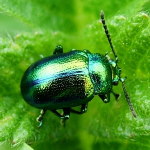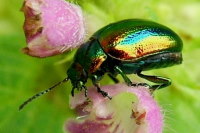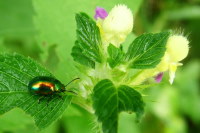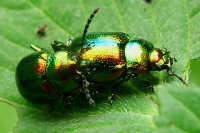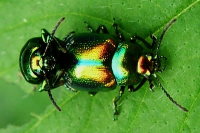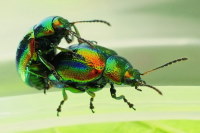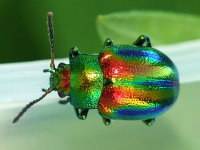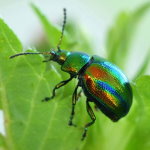Phylum Arthropoda (Arthropods) ➔ Subphylum Hexapoda (Hexapods) ➔ Class Insecta (Insects) ➔ Order Coleoptera (Beetles) ➔ Family Chrysomelidae (Leaf beetles)
Chrysolina (Fastuolina) fastuosa (Scopoli, 1763)
Prächtiger Blattkäfer Dead-nettle Leaf Beetle
Synonyms and other combinations:
Coccinella fastuosa Scopoli, 1763 [original combination] | Dlochrysa fastuosa (Scopoli, 1763) |
Classification:
Chrysolina fastuosa belongs to the subfamily Chrysomelinae, tribe Doryphorini.Distribution:
Widespread in Europe.Habitat:
Forest edges, roadsides, ruderal areas and extensive grassland.Description:
Length 5 - 6 mm; upper side gold-green glossy; elytra mostly with variable blue or reddish longitudinal stripes; oval eyes; claw tarsomer of front tarsi below with a strong tooth.Biology:
The Dead-nettle Leaf Beetle Chrysolina fastuosa forms one generation per year.The oligophagous species lives on labiates (Lamiaceae) of the genus hemp-nettle (Galeopsis), as well as on some species of deadnettle (Lamium). The imagines appearing in spring first feed on white deadnettle (Lamium album) and then change to the later germinating hemp-nettle. The pale yellow eggs are deposited in the calyxes on the young seeds from June to July. After hatching, the larvae initially eat the seeds and calyxes at night, later they also feed on the underside of leaves. During the day they hide in the seed capsules. In September, after the end of the feeding phase, the larvae are fully developed and go several centimetres deep into the ground to pupate.
About hibernation of Chrysolina fastuosa different data are available. These include hibernation as larva (pre-pupa) or pupa and also as imago.
References, further reading, links:
- Rheinheimer, Joachim, & Hassler, Michael: Die Blattkäfer Baden-Württembergs, 2018, 928 pages, Kleinsteuber Books (Karlsruhe), ISBN 978-3-9818110-2-5
- Altica sp.
- Bruchus sp.
- Cassida nebulosa
- Cassida sp.
- Cassida stigmatica
- Cassida vibex
- Cassida vibex/bergeali
- Chrysolina lucidicollis
- Chrysolina oricalcia
- Chrysolina sp.
- Chrysolina sturmi
- Chrysolina varians
- Chrysomela tremula
- Coptocephala sp.
- Crepidodera aurea
- Crepidodera fulvicornis
- Cryptocephalus moraei
- Cryptocephalus nitidus
- Cryptocephalus pusillus
- Cryptocephalus sp.
- Donacia cinerea
- Donacia marginata
- Donacia versicolorea
- Galeruca tanaceti
- Galerucella s.l.
- Gonioctena decemnotata
- Gonioctena quinquepunctata
- Gonioctena sp.
- Gonioctena viminalis
- Lema cyanella
- Neocrepidodera sp.
- Oulema melanopus/duftschmidi
- Oulema obscura
- Pachybrachis sp.
- Phratora sp.
- Plagiosterna aenea
- Plateumaris sp.
- Podagrica fuscicornis
- Psylliodes sp.
- Sphaeroderma sp.
- Gonioctena quinquepunctata/intermedia
- Alder Leaf Beetle
- Ant Bag Beetle
- Barley Flea Beetle
- Brassy Willow Leaf Beetle
- Broad Bean Weevil
- Case-bearing Leaf Beetles
- Colorado Potato Beetle
- Dead-nettle Leaf Beetle
- Elm Leaf Beetle
- Four Spotted Leaf Beetle
- Green Dock Beetle
- Green Tortoise Beetle
- Horseradish Flea Beetle
- Imported Willow Leaf Beetle
- Iris Flea Beetle
- Lily Leaf Beetle
- Plantain Leaf Beetle
- Poplar Leaf Beetle
- Skullcap Leaf Beetle
- Spotted Asparagus Beetle
- Spotted Willow Leaf Beetle
- St John's-wort Leaf Beetle
- Thistle Tortoise Beetle
- Turnip Flea Beetle
- Two-tone Reed Beetle
- Viburnum Leaf Beetle
- Western Grape Rootworm
- Wheat Flea Beetle
- Willow Flea Beetle
- Willow Leaf Beetle
